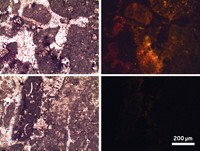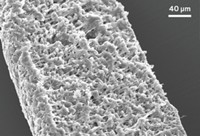Advertisement
Grab your lab coat. Let's get started
Welcome!
Welcome!
Create an account below to get 6 C&EN articles per month, receive newsletters and more - all free.
It seems this is your first time logging in online. Please enter the following information to continue.
As an ACS member you automatically get access to this site. All we need is few more details to create your reading experience.
Not you? Sign in with a different account.
Not you? Sign in with a different account.
ERROR 1
ERROR 1
ERROR 2
ERROR 2
ERROR 2
ERROR 2
ERROR 2
Password and Confirm password must match.
If you have an ACS member number, please enter it here so we can link this account to your membership. (optional)
ERROR 2
ACS values your privacy. By submitting your information, you are gaining access to C&EN and subscribing to our weekly newsletter. We use the information you provide to make your reading experience better, and we will never sell your data to third party members.
Art & Artifacts
Biosensor finds first evidence of silk in ancient Chinese shipwreck
Results provide missing insight into an 800-year-old merchant ship from the Silk Road era
by Prachi Patel, special to C&EN
December 31, 2019
| A version of this story appeared in
Volume 98, Issue 1

For hundreds of years, ships laden with porcelain, tea, and gold voyaged from China’s southern coast to Southeast Asia, the Mediterranean, and Europe, on what was the oceanic part of the historic Silk Road, the trade network connecting the East and the West from about 130 BCE to 1453 CE. Archaeologists have recovered many artifacts from shipwrecks along this route, yet among these oceanic relics, no one has ever found remnants of the precious material that gave the network its name: silk.
But now, using an ultrasensitive biosensor, researchers have found the first tiny traces of silk in samples taken from sediments within the cabin of an exceptionally well-preserved shipwreck discovered at the mouth of China’s Pearl River, a starting point of the Maritime Silk Road (ACS Sensors 2019, DOI: 10.1021/acssensors.9b01638). The technique could help fill gaps in knowledge of oceanic trade routes, since most of what is known about the Silk Road comes from land routes.
Silk degrades quickly in the warm waters south of Asia. But traces of the insoluble silk protein fibroin can remain in clay. To detect fibroin traces in soil from underwater archaeological sites, Bing Wang of Zhejiang Sci-Tech University, Yang Zhou of the China National Silk Museum, and their colleagues developed a biosensor called an electrochemical immunosensor.
These recently developed devices use antibodies to capture target molecules and detect the tiny electrical signal produced when the two molecules bind together. Because of their accuracy, electrochemical immunosensors have been used in medical diagnostics, food fraud detection, and forensics. The team is the first to use this type of device to look for archaeological evidence of silk, says Mehdi Moini, a forensic chemist and chief scientific officer at Picolytics, an analytics R&D company focusing on applications including cultural heritage. Moini was not involved in the study.
To make the sensor, the team coated a carbon electrode with gold nanoparticles and then added drops of a designer antibody they made in their laboratory. The antibodies bind to the gold nanoparticles and also have a strong affinity for silk fibroin. The current from the device spikes when the antibodies capture silk fibroin.
The researchers tested the device on three soil samples, each from a different part of the Nanhai No. 1 shipwreck, the remains of a Chinese merchant ship sunk between 1127 and 1279. While the ship is now housed at the Guangdong Maritime Silk Road Museum in an underwater environment, explorations of the wreck have revealed 180,000 relics, including porcelain, metal, glass, and human remains. But archaeologists have not yet found silk products.
Although two samples showed negative results, the third sample generated an electrical signal in the immunosensor, indicating the presence of microtraces of silk fibroin. The researchers diluted that sample from a concentration of 1µg/mL to 0.01 µg/mL to demonstrate the sensitivity of the technique. All the samples detected fibroin.
“These findings are novel in their detection of silk traces at very low levels in a complex mixture under harsh environmental conditions that exist near the ocean,” Moini says. The technique will allow “the identification of silk at various archaeological sites where silk fabric has completely degraded to dust and has mixed with soil.”
However, he believes the researchers will need to test many more samples to demonstrate that the sensor is reliable and to conclusively prove the detection of archaeological silk at these sites. Sensitive mass spectrometery techniques, for instance, could help to confirm the results and validate the device. Plus, archaeological samples are prone to contamination, so “even after proving that you have a silk sample, you still need to prove that it is truly archaeological in nature,” which requires further testing with techniques such as dye and pigment analysis that can determine age, he says.





Join the conversation
Contact the reporter
Submit a Letter to the Editor for publication
Engage with us on Twitter